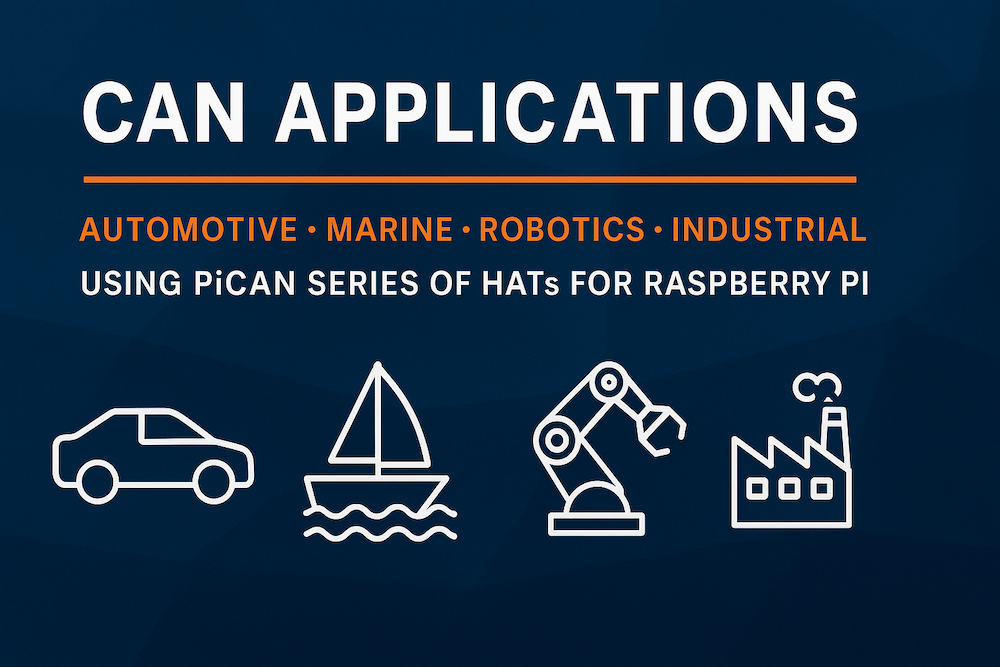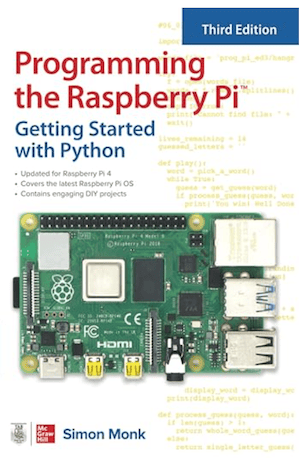Recent Posts
CAN Bus Applications in Automotive, Marine, Robotics, and Industrial Systems Using the PiCAN Series of HATs for Raspberry Pi
Posted by on
 The Controller Area Network (CAN Bus) is a resilient, lightweight, and highly efficient communication protocol originally developed by Bosch in the 1980s for automotive systems. Today, CAN Bus has evolved far beyond its automotive roots, extending into marine electronics, robotics, industrial automation, and more. One of the most accessible and flexible ways to prototype or implement CAN-based systems is through the Raspberry Pi platform, particularly when paired with specialized HATs (Hardware Attached on Top) such as the PiCAN series offered by Copperhill Technologies.
The Controller Area Network (CAN Bus) is a resilient, lightweight, and highly efficient communication protocol originally developed by Bosch in the 1980s for automotive systems. Today, CAN Bus has evolved far beyond its automotive roots, extending into marine electronics, robotics, industrial automation, and more. One of the most accessible and flexible ways to prototype or implement CAN-based systems is through the Raspberry Pi platform, particularly when paired with specialized HATs (Hardware Attached on Top) such as the PiCAN series offered by Copperhill Technologies.
This article explores the broad landscape of CAN Bus applications across multiple industries and highlights how the PiCAN HATs facilitate rapid development, robust performance, and seamless integration—especially when programmed via SocketCAN, the Linux-native CAN interface.
Understanding the Power of CAN Bus
CAN Bus is a multi-master, message-oriented protocol designed to allow microcontrollers and devices to communicate without a host computer. It is deterministic, meaning it guarantees message delivery based on message priority, which is crucial for real-time systems. CAN’s error-handling, low wiring complexity, and ability to operate in electrically noisy environments make it ideal for embedded systems that require reliability and robustness.
PiCAN HATs: Versatile CAN Interfaces for Raspberry Pi
The PiCAN series by Copperhill Technologies includes a range of CAN HATs tailored for different use cases. These boards bring professional-grade CAN capabilities to the Raspberry Pi, making it a compelling platform for prototyping, diagnostics, and deployment. Every PiCAN board supports SocketCAN, the powerful open-source CAN interface on Linux, which allows for flexible and user-friendly programming.
Let’s briefly examine some of the key PiCAN HATs and their technical features:
1. PiCAN2 CAN Bus HAT
-
Features a single CAN channel based on the MCP2515 CAN controller with MCP2551 CAN transceiver.
-
SocketCAN support through the
spi-caninterface. -
Optional onboard 5VDC 1A SMPS for powering the Pi through the HAT.
-
Suitable for basic CAN communication in automotive or robotics systems.
2. PiCAN2 Duo – Dual CAN Bus HAT
-
Offers two independent CAN Bus channels.
-
Ideal for bridge or gateway applications, such as translating between different CAN networks or protocols like J1939 and CANopen.
-
Includes an optional onboard SMPS.
-
A great tool for advanced automotive and industrial applications requiring multi-bus interaction.
3. PiCAN3 – Enhanced CAN Bus HAT
-
Designed for the Raspberry Pi 4, uses an MCP2517FD CAN controller.
-
Supports CAN FD (Flexible Data Rate), enabling faster and larger data transfers.
-
Compatible with SAE J1939 and modern automotive ECUs.
-
Perfect for high-bandwidth diagnostics and modern vehicle networks.
4. PiCAN3 Duo – Dual CAN FD Bus HAT
-
Combines all the benefits of CAN FD and dual-bus capabilities.
-
Well-suited for marine systems and industrial controllers with multiple CAN networks.
-
Features galvanic isolation, protecting hardware from electrical surges.
5. PiCAN-M – Marine NMEA 2000 HAT
-
Specifically developed for marine applications and compatible with NMEA 2000, a marine variant of CAN Bus.
-
Comes with a DB9 connector wired to the NMEA 2000 standard.
-
Ideal for interfacing with marine GPS, depth sounders, AIS systems, and other boat electronics.
6. PiCAN FD with GPS/GNSS Support
-
Integrates a u-blox GNSS module for position tracking alongside CAN FD.
-
A top choice for developing fleet management, telematics, or robotics systems requiring real-time location data.
-
Especially relevant in autonomous robotics and smart marine navigation.
7. PiCAN2 with 3A SMPS & 9-pin D-sub
-
Designed for heavy-duty industrial use where external power sourcing is needed.
-
Includes high-current SMPS and industry-standard DB9 CAN connector.
-
Tailored for rugged deployments like factory automation or large-scale robotics systems.
Applications Across Industries
Automotive
CAN Bus remains the de facto standard in automotive communications, used in everything from engine control units (ECUs) and transmission systems to ADAS (Advanced Driver Assistance Systems) and infotainment. The PiCAN2 and PiCAN3 are excellent tools for:
-
Developing aftermarket ECUs or dashboards.
-
Vehicle diagnostics and telemetry.
-
Electric vehicle battery management system (BMS) prototyping.
-
Testing autonomous vehicle subsystems with GPS-capable variants.
Marine
Marine electronics increasingly depend on NMEA 2000, which is built on the CAN protocol. The PiCAN-M simplifies development in this field by offering plug-and-play compatibility. Potential applications include:
-
Multi-device marine network prototyping (e.g., GPS, sonar, engine sensors).
-
Data logging of NMEA 2000 traffic for marine analytics.
-
Creating cost-effective marine automation tools (e.g., autopilots, tank monitors).
Robotics
Robots often have distributed control systems, where motor drivers, sensors, and processors must communicate in real-time. CAN Bus, with its deterministic messaging and high resilience, fits this paradigm well. PiCAN HATs support:
-
Autonomous mobile robots (AMRs) and AGVs with modular communication.
-
Industrial manipulators with multi-node joint control.
-
Swarm robotics using CAN FD and GPS for location-aware collaboration.
Industrial Automation
In industrial environments, CAN is used for fieldbus protocols such as CANopen and DeviceNet. The PiCAN2 Duo or PiCAN3 Duo enables:
-
Bridging legacy CANopen machines with newer systems.
-
Logging and analysis of plant communication traffic.
-
Development of programmable logic controller (PLC) extensions or diagnostic tools.
Why SocketCAN Matters
All PiCAN HATs are compatible with SocketCAN, which integrates CAN support into the Linux network stack. This brings a number of advantages:
-
Simple command-line utilities (
candump,cansend,ip link, etc.). -
Easy integration with Python, C, or Rust applications.
-
Compatibility with widely used diagnostic tools like Wireshark.
-
Reduced development time and easier debugging during prototyping.
SocketCAN effectively transforms CAN programming from an esoteric challenge into a familiar networking task. This allows developers, hobbyists, and engineers to focus more on the application and less on the low-level protocol.
Conclusion
The PiCAN series of HATs bridges the gap between powerful CAN Bus capabilities and the flexibility of the Raspberry Pi platform. Whether you're building an in-vehicle diagnostics tool, a GPS-enabled autonomous drone, or a marine electronics control panel, these boards provide a scalable, reliable, and well-supported path for development. With SocketCAN support, users can integrate CAN communication into their systems quickly and with minimal friction.
As CAN Bus technology continues to evolve with trends like CAN FD and TSN (Time-Sensitive Networking), the PiCAN HAT ecosystem ensures that developers remain at the cutting edge of communication technology—without the need for expensive proprietary tools.
 Programming the Raspberry Pi: Getting Started with Python
Programming the Raspberry Pi: Getting Started with Python
This is your fully updated guide to building creative projects and fun games on the Raspberry Pi—no prior programming experience needed. This edition reflects the latest hardware updates, OS enhancements, and setup procedures introduced with Raspberry Pi OS version 4.
You’ll learn how to configure your Raspberry Pi, set up its software environment, and begin writing Python scripts from scratch. The book covers the essentials of Python programming while guiding you through the creation of user-friendly graphical interfaces and the control of external electronic components.
Step-by-step projects include a working digital clock and a fully functional Raspberry Pi-powered robot.
What you’ll learn:
-
Set up and configure your Raspberry Pi hardware and software
-
Write, run, and debug Python programs
-
Master Python fundamentals, including strings, lists, functions, and dictionaries
-
Explore advanced concepts such as modules, classes, and object-oriented development
-
Create interactive games using the Pygame library
-
Design user interfaces with the guizero framework
-
Control LEDs, sensors, and motors using the gpiozero library
-
Build electronics projects via the Raspberry Pi’s GPIO pins
Whether you're a student, educator, or hobbyist, this hands-on guide offers everything you need to start programming and prototyping with confidence. More information...
 Loading... Please wait...
Loading... Please wait...
